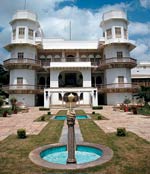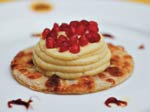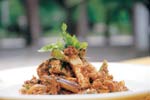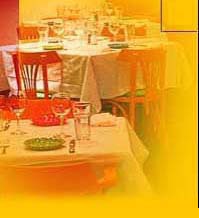 THE best way to get to Gwalior is to take a train. I caught the Shatabdi Express that pulled out of Delhi Railway Station at the uncivilised hour of 6.15 a.m. A wizened porter stood at platform�s edge, shining lantern in hand, furiously waving a green flag. Yes, in this day and age. Although the train was relatively modern, with huge French glass windows that let in the North Indian countryside, piped music, and an uniformed attendant who served breakfast and Bisleri water. Outside the sun was just rising over the new flyovers that are coming up in the capital, but Delhi was awake, and more importantly � Delhi was on the march. Already I could see traffic jams building up and I was glad I had not chosen to go by road. I am told the road journey between Delhi and Gwalior takes a good six hours. People who have done it, have regretted; the condition of the National Highway is appalling, and they reached journey�s end after an eight-hour bone-jarring journey. The Shatabdi, that pride of the Indian Railways, does Delhi-Agra-Gwalior in 3.15 hours. I was gently deposited on Gwalior Railway Station by 9.30. They give you just five minutes to get off, luggage and all, then the train moves on to keep its appointment with Bhopal, the next destination. From the station to the Usha Kiran Palace, which is the only hotel you must stay at if you�re visiting Gwalior, is a 10 km-run. A good car and driver will get you there in as many minutes. And you will be in time for breakfast at the Silver Saloon Restaurant, a real Gwalior breakfast of Masaledar Poha, Poori Bhaji, Paratha-Dahi, and tea. You cannot hope for a better welcome to the hotel and city. My advise is to have your breakfast first, then go through the formalities of checking in. You room will wait, the Poha and Poori Bhaji will not. THE best way to get to Gwalior is to take a train. I caught the Shatabdi Express that pulled out of Delhi Railway Station at the uncivilised hour of 6.15 a.m. A wizened porter stood at platform�s edge, shining lantern in hand, furiously waving a green flag. Yes, in this day and age. Although the train was relatively modern, with huge French glass windows that let in the North Indian countryside, piped music, and an uniformed attendant who served breakfast and Bisleri water. Outside the sun was just rising over the new flyovers that are coming up in the capital, but Delhi was awake, and more importantly � Delhi was on the march. Already I could see traffic jams building up and I was glad I had not chosen to go by road. I am told the road journey between Delhi and Gwalior takes a good six hours. People who have done it, have regretted; the condition of the National Highway is appalling, and they reached journey�s end after an eight-hour bone-jarring journey. The Shatabdi, that pride of the Indian Railways, does Delhi-Agra-Gwalior in 3.15 hours. I was gently deposited on Gwalior Railway Station by 9.30. They give you just five minutes to get off, luggage and all, then the train moves on to keep its appointment with Bhopal, the next destination. From the station to the Usha Kiran Palace, which is the only hotel you must stay at if you�re visiting Gwalior, is a 10 km-run. A good car and driver will get you there in as many minutes. And you will be in time for breakfast at the Silver Saloon Restaurant, a real Gwalior breakfast of Masaledar Poha, Poori Bhaji, Paratha-Dahi, and tea. You cannot hope for a better welcome to the hotel and city. My advise is to have your breakfast first, then go through the formalities of checking in. You room will wait, the Poha and Poori Bhaji will not.
 The Usha Kiran Palace is over 120 years old, I cannot tell you its exact age, but it was built by Maharaja Jayaji Rao Scindia as an annexe to his Jai Vilas Palace next door and meant to host the King and Queen of England who were visiting. His grandson, Maharaja Jiwaji Rao Scindia, made this his royal residence, preferring its quiet, wooded surroundings to the grandeur of the adjoining Jai Vilas Palace. But the Usha Kiran is still a gracious old palace, standing on nine acres of landscaped lawns and manicured gardens, with fountains sprouting water and birds singing in the trees. The Taj Group of Hotels, which took it up some years ago, has not made many changes to the palace, in fact I believe they meticulously restored its original architecture. The courtyards are still magnificent, the palace that is now the heritage hotel has artistic stone carvings and delicate filigree work, and it is noted for its carved sandstone screens. The Taj has added its Jiva Spa to the Usha Kiran Palace�s gardens where live musicians serenade guests with soothing strains of Indian classical music during their aroma therapy treatments. And, of course, a large swimming pool has come up under the shade of old oak trees, plus a well-equipped fitness centre, a splash pool and a billiards table in the bar. The rooms, luxury villas and royal residences, which are designed in Indo-Western style, are regal and palatial. They offer contemporary comforts. Canopied four-poster beds, Chanderi silk bedspreads, and framed black-and-white photographs of the Scindias gone by offer a harmonious blend of modernity with old world charm. The furnishings are luxurious, Indian style divans and silk cushions, antique Venetian mirrors and mother-of-pearl mosaics, marble baths and private sunlit terraces. The Usha Kiran Palace is over 120 years old, I cannot tell you its exact age, but it was built by Maharaja Jayaji Rao Scindia as an annexe to his Jai Vilas Palace next door and meant to host the King and Queen of England who were visiting. His grandson, Maharaja Jiwaji Rao Scindia, made this his royal residence, preferring its quiet, wooded surroundings to the grandeur of the adjoining Jai Vilas Palace. But the Usha Kiran is still a gracious old palace, standing on nine acres of landscaped lawns and manicured gardens, with fountains sprouting water and birds singing in the trees. The Taj Group of Hotels, which took it up some years ago, has not made many changes to the palace, in fact I believe they meticulously restored its original architecture. The courtyards are still magnificent, the palace that is now the heritage hotel has artistic stone carvings and delicate filigree work, and it is noted for its carved sandstone screens. The Taj has added its Jiva Spa to the Usha Kiran Palace�s gardens where live musicians serenade guests with soothing strains of Indian classical music during their aroma therapy treatments. And, of course, a large swimming pool has come up under the shade of old oak trees, plus a well-equipped fitness centre, a splash pool and a billiards table in the bar. The rooms, luxury villas and royal residences, which are designed in Indo-Western style, are regal and palatial. They offer contemporary comforts. Canopied four-poster beds, Chanderi silk bedspreads, and framed black-and-white photographs of the Scindias gone by offer a harmonious blend of modernity with old world charm. The furnishings are luxurious, Indian style divans and silk cushions, antique Venetian mirrors and mother-of-pearl mosaics, marble baths and private sunlit terraces.
 That is all I will tell you about the hotel. Let us move onto the spa and restaurant, now. The Jiva Spa is a wonderful place, it is set in the midst of nature, and offers everything to revive body and soul. It is located in the palace gardens, equipped with single and double treatment suites, a meditation garden cocooned within ancient pillars, an open heritage courtyard, and staffed by therapists with gifted hands, light feet and a soothing touch. Jayanti Gomes, the bright young manager of this Jiva Spa, is a trained therapist herself. She recommends the treatments that are specifically designed to maintain physical, mental and spiritual equilibrium. All with aromatic Ayurvedic oil blends. The Pehelwan Malish for me, once a power massage meant for Indian wrestlers, in which mustard oil provides warm relief for my sore and tense muscles. And the malish given not by some strong ex-pehelwan of an erstwhile Gwalior akhada, but a delicate and beautiful Naga girl with soft features and a firm stroke. For Farzana Contractor, Jayanti recommended the Mangal Snan, it is Jiva Spa�s signature treatment, and once a privilege reserved for royalty. Farzana later told me, she was treated like a royal guest, the Mangal Snan is a full body treatment and a sensual experience. Musicians serenaded her as the therapist got to work with age-old herbs, oils and royal spices and gave Farzana a deep cleansing, exfoliating and calming massage. �It ended in an imperial saffron bath,� she reported, amused and secretly thrilled by the experience. That is all I will tell you about the hotel. Let us move onto the spa and restaurant, now. The Jiva Spa is a wonderful place, it is set in the midst of nature, and offers everything to revive body and soul. It is located in the palace gardens, equipped with single and double treatment suites, a meditation garden cocooned within ancient pillars, an open heritage courtyard, and staffed by therapists with gifted hands, light feet and a soothing touch. Jayanti Gomes, the bright young manager of this Jiva Spa, is a trained therapist herself. She recommends the treatments that are specifically designed to maintain physical, mental and spiritual equilibrium. All with aromatic Ayurvedic oil blends. The Pehelwan Malish for me, once a power massage meant for Indian wrestlers, in which mustard oil provides warm relief for my sore and tense muscles. And the malish given not by some strong ex-pehelwan of an erstwhile Gwalior akhada, but a delicate and beautiful Naga girl with soft features and a firm stroke. For Farzana Contractor, Jayanti recommended the Mangal Snan, it is Jiva Spa�s signature treatment, and once a privilege reserved for royalty. Farzana later told me, she was treated like a royal guest, the Mangal Snan is a full body treatment and a sensual experience. Musicians serenaded her as the therapist got to work with age-old herbs, oils and royal spices and gave Farzana a deep cleansing, exfoliating and calming massage. �It ended in an imperial saffron bath,� she reported, amused and secretly thrilled by the experience.
And now the food � ah, the food! All your dining experiences at the Usha Kiran Palace you ought to leave in the expert hands of the hotel�s jovial young executive chef, Sibabrat Sahu. He is Oriya, but the food he cooks in Gwalior is Maratha and Nepalese, that�s because the royal Scindia family is Maharashtrian and the daughters-in-law have somehow managed to be Nepalese princesses. So the menu of the Silver Spoon Restaurant takes its inspiration from history and offers signature cuisine that was once the preserve of the Maratha and Nepal royal families. There is no Gwalior cuisine as such, whatever is acceptable in North India, is fine here. And there are no restaurants that serve local fare. But the Maratha and Nepalese food are to die for, and not just the palace and hotel, but several Gwalior families dine on this cuisine. Chef Sahu does not offer typical Maratha meals, nor specific menus, but he follows hundred year old recipes from the royal palace that were given to him by the Maharani Priyaraje Scindia herself. The menu at the Silver Spoon has 13 dishes. I counted them. A Tomato che Saar and a Masala Chaas that go under the heading of �Soups�; Bharleli Vangi, Vada Kombda, Paneer ka Achar, Daal Chicken, Lamb Barbat, Amti, and Varan as the �Main Course�; to be had with Masala Bhaat that is herbed and spiced rice cooked on dum or a Poli of puffed wheat; and, for dessert, Shrikhand flavoured with saffron and cardamon, or Puran Poli. �This kind of food it is difficult to get in the city,� Chef Sahu said. �People make it at home, but they invite outsiders only on special occasions, like Dashera. That�s when you taste traditional Shrikhand. And Boondhi Ladoos in pure ghee.� Of his Maratha menu, I was fascinated by the Daal Chicken. The chicken that is used is local, not country chicken � for that, there is no demand. Only the dhabas on the highway ask for deshi murghas. The dish is spicy, something like a Mughlai Dal Gosht, but given its fiery flavour by the Maharashtrian Kala Masala made of 15 spices. Chef Sahu named them: �There is black cardamom, shahi jeera, stone flower, mace, nutmeg, green cardamom, Szechwan pepper, cumin, cinnamon, black peppercorn, star anise, cloves, bayleaves, dry red chillies, and coriander seeds. All Maharashtrian families in Gwalior grind this masala and keep it at home. It is the mainstay of their Maratha cuisine.� I suggest, have lunch at the Silver Spoon, take a table near the window � they overlook the verdant courtyard, or you could also sit out in the courtyard for an alfresco dining experience in the palm-shaped court or in the verandah, amidst vistas of greenery. And ask Chef Sahu to do the complete Maratha menu for you. It is just 13 dishes, but worth the experience, and have it course by course slowly, sipping the Masala Chaas in between. This will act as a digestive for the previous course and an aperitif for the next. Then, after you have slept off the meal, report to the Jiva Spa for your massage. Not the Pehelwan Maalish, but the Vishrama, it is more relaxing.
|




 THE best way to get to Gwalior is to take a train. I caught the Shatabdi Express that pulled out of Delhi Railway Station at the uncivilised hour of 6.15 a.m. A wizened porter stood at platform�s edge, shining lantern in hand, furiously waving a green flag. Yes, in this day and age. Although the train was relatively modern, with huge French glass windows that let in the North Indian countryside, piped music, and an uniformed attendant who served breakfast and Bisleri water. Outside the sun was just rising over the new flyovers that are coming up in the capital, but Delhi was awake, and more importantly � Delhi was on the march. Already I could see traffic jams building up and I was glad I had not chosen to go by road. I am told the road journey between Delhi and Gwalior takes a good six hours. People who have done it, have regretted; the condition of the National Highway is appalling, and they reached journey�s end after an eight-hour bone-jarring journey. The Shatabdi, that pride of the Indian Railways, does Delhi-Agra-Gwalior in 3.15 hours. I was gently deposited on Gwalior Railway Station by 9.30. They give you just five minutes to get off, luggage and all, then the train moves on to keep its appointment with Bhopal, the next destination. From the station to the Usha Kiran Palace, which is the only hotel you must stay at if you�re visiting Gwalior, is a 10 km-run. A good car and driver will get you there in as many minutes. And you will be in time for breakfast at the Silver Saloon Restaurant, a real Gwalior breakfast of Masaledar Poha, Poori Bhaji, Paratha-Dahi, and tea. You cannot hope for a better welcome to the hotel and city. My advise is to have your breakfast first, then go through the formalities of checking in. You room will wait, the Poha and Poori Bhaji will not.
THE best way to get to Gwalior is to take a train. I caught the Shatabdi Express that pulled out of Delhi Railway Station at the uncivilised hour of 6.15 a.m. A wizened porter stood at platform�s edge, shining lantern in hand, furiously waving a green flag. Yes, in this day and age. Although the train was relatively modern, with huge French glass windows that let in the North Indian countryside, piped music, and an uniformed attendant who served breakfast and Bisleri water. Outside the sun was just rising over the new flyovers that are coming up in the capital, but Delhi was awake, and more importantly � Delhi was on the march. Already I could see traffic jams building up and I was glad I had not chosen to go by road. I am told the road journey between Delhi and Gwalior takes a good six hours. People who have done it, have regretted; the condition of the National Highway is appalling, and they reached journey�s end after an eight-hour bone-jarring journey. The Shatabdi, that pride of the Indian Railways, does Delhi-Agra-Gwalior in 3.15 hours. I was gently deposited on Gwalior Railway Station by 9.30. They give you just five minutes to get off, luggage and all, then the train moves on to keep its appointment with Bhopal, the next destination. From the station to the Usha Kiran Palace, which is the only hotel you must stay at if you�re visiting Gwalior, is a 10 km-run. A good car and driver will get you there in as many minutes. And you will be in time for breakfast at the Silver Saloon Restaurant, a real Gwalior breakfast of Masaledar Poha, Poori Bhaji, Paratha-Dahi, and tea. You cannot hope for a better welcome to the hotel and city. My advise is to have your breakfast first, then go through the formalities of checking in. You room will wait, the Poha and Poori Bhaji will not.
 The Usha Kiran Palace is over 120 years old, I cannot tell you its exact age, but it was built by Maharaja Jayaji Rao Scindia as an annexe to his Jai Vilas Palace next door and meant to host the King and Queen of England who were visiting. His grandson, Maharaja Jiwaji Rao Scindia, made this his royal residence, preferring its quiet, wooded surroundings to the grandeur of the adjoining Jai Vilas Palace. But the Usha Kiran is still a gracious old palace, standing on nine acres of landscaped lawns and manicured gardens, with fountains sprouting water and birds singing in the trees. The Taj Group of Hotels, which took it up some years ago, has not made many changes to the palace, in fact I believe they meticulously restored its original architecture. The courtyards are still magnificent, the palace that is now the heritage hotel has artistic stone carvings and delicate filigree work, and it is noted for its carved sandstone screens. The Taj has added its Jiva Spa to the Usha Kiran Palace�s gardens where live musicians serenade guests with soothing strains of Indian classical music during their aroma therapy treatments. And, of course, a large swimming pool has come up under the shade of old oak trees, plus a well-equipped fitness centre, a splash pool and a billiards table in the bar. The rooms, luxury villas and royal residences, which are designed in Indo-Western style, are regal and palatial. They offer contemporary comforts. Canopied four-poster beds, Chanderi silk bedspreads, and framed black-and-white photographs of the Scindias gone by offer a harmonious blend of modernity with old world charm. The furnishings are luxurious, Indian style divans and silk cushions, antique Venetian mirrors and mother-of-pearl mosaics, marble baths and private sunlit terraces.
The Usha Kiran Palace is over 120 years old, I cannot tell you its exact age, but it was built by Maharaja Jayaji Rao Scindia as an annexe to his Jai Vilas Palace next door and meant to host the King and Queen of England who were visiting. His grandson, Maharaja Jiwaji Rao Scindia, made this his royal residence, preferring its quiet, wooded surroundings to the grandeur of the adjoining Jai Vilas Palace. But the Usha Kiran is still a gracious old palace, standing on nine acres of landscaped lawns and manicured gardens, with fountains sprouting water and birds singing in the trees. The Taj Group of Hotels, which took it up some years ago, has not made many changes to the palace, in fact I believe they meticulously restored its original architecture. The courtyards are still magnificent, the palace that is now the heritage hotel has artistic stone carvings and delicate filigree work, and it is noted for its carved sandstone screens. The Taj has added its Jiva Spa to the Usha Kiran Palace�s gardens where live musicians serenade guests with soothing strains of Indian classical music during their aroma therapy treatments. And, of course, a large swimming pool has come up under the shade of old oak trees, plus a well-equipped fitness centre, a splash pool and a billiards table in the bar. The rooms, luxury villas and royal residences, which are designed in Indo-Western style, are regal and palatial. They offer contemporary comforts. Canopied four-poster beds, Chanderi silk bedspreads, and framed black-and-white photographs of the Scindias gone by offer a harmonious blend of modernity with old world charm. The furnishings are luxurious, Indian style divans and silk cushions, antique Venetian mirrors and mother-of-pearl mosaics, marble baths and private sunlit terraces.
 That is all I will tell you about the hotel. Let us move onto the spa and restaurant, now. The Jiva Spa is a wonderful place, it is set in the midst of nature, and offers everything to revive body and soul. It is located in the palace gardens, equipped with single and double treatment suites, a meditation garden cocooned within ancient pillars, an open heritage courtyard, and staffed by therapists with gifted hands, light feet and a soothing touch. Jayanti Gomes, the bright young manager of this Jiva Spa, is a trained therapist herself. She recommends the treatments that are specifically designed to maintain physical, mental and spiritual equilibrium. All with aromatic Ayurvedic oil blends. The Pehelwan Malish for me, once a power massage meant for Indian wrestlers, in which mustard oil provides warm relief for my sore and tense muscles. And the malish given not by some strong ex-pehelwan of an erstwhile Gwalior akhada, but a delicate and beautiful Naga girl with soft features and a firm stroke. For Farzana Contractor, Jayanti recommended the Mangal Snan, it is Jiva Spa�s signature treatment, and once a privilege reserved for royalty. Farzana later told me, she was treated like a royal guest, the Mangal Snan is a full body treatment and a sensual experience. Musicians serenaded her as the therapist got to work with age-old herbs, oils and royal spices and gave Farzana a deep cleansing, exfoliating and calming massage. �It ended in an imperial saffron bath,� she reported, amused and secretly thrilled by the experience.
That is all I will tell you about the hotel. Let us move onto the spa and restaurant, now. The Jiva Spa is a wonderful place, it is set in the midst of nature, and offers everything to revive body and soul. It is located in the palace gardens, equipped with single and double treatment suites, a meditation garden cocooned within ancient pillars, an open heritage courtyard, and staffed by therapists with gifted hands, light feet and a soothing touch. Jayanti Gomes, the bright young manager of this Jiva Spa, is a trained therapist herself. She recommends the treatments that are specifically designed to maintain physical, mental and spiritual equilibrium. All with aromatic Ayurvedic oil blends. The Pehelwan Malish for me, once a power massage meant for Indian wrestlers, in which mustard oil provides warm relief for my sore and tense muscles. And the malish given not by some strong ex-pehelwan of an erstwhile Gwalior akhada, but a delicate and beautiful Naga girl with soft features and a firm stroke. For Farzana Contractor, Jayanti recommended the Mangal Snan, it is Jiva Spa�s signature treatment, and once a privilege reserved for royalty. Farzana later told me, she was treated like a royal guest, the Mangal Snan is a full body treatment and a sensual experience. Musicians serenaded her as the therapist got to work with age-old herbs, oils and royal spices and gave Farzana a deep cleansing, exfoliating and calming massage. �It ended in an imperial saffron bath,� she reported, amused and secretly thrilled by the experience.